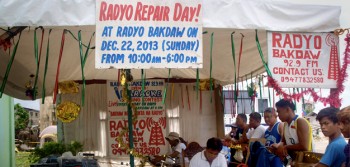This is the second report from Viviane Lucia Fluck, a disaster communications researcher, who has been volunteering at Radyo Bakdaw, a station set up by Internews where Typhoon Haiyan made landfall in the Philippines.
 After the typhoon, most radios in the affected areas were lost or broken. Although right now radio seems like the most trusted source of information, few Guiuan residents have a functioning radio or the means to buy a new one.
After the typhoon, most radios in the affected areas were lost or broken. Although right now radio seems like the most trusted source of information, few Guiuan residents have a functioning radio or the means to buy a new one.
Sunday 22 December was the first Radio Repair Day at Radyo Bakdaw. Three technicians, one of whom bears a striking resemblance to Pinocchio’s Geppetto, are setting up their gear on tables outside the radio station. Six radios have already been waiting in the station’s studio since early morning. The question is: can they actually be repaired?
A few people hang around to watch the first three radio beings fixed. Before too long the technicians manage to get static coming out of the battered boxes, which look more like sad vestiges of radios than anything that can play a sound. But a moment later there it is – Radyo Bakdaw is coming loud and clear out of the battered skeleton of a radio.
 Over the course of the day, no less than 51 radios are brought to Radyo Bakdaw’s “doctors” and with two exceptions they revive all of them. Whether they are in the form of wooden cases, big boomboxes or small enough to be worn around the neck – all of the radios seem to be treasured by their owners.
Over the course of the day, no less than 51 radios are brought to Radyo Bakdaw’s “doctors” and with two exceptions they revive all of them. Whether they are in the form of wooden cases, big boomboxes or small enough to be worn around the neck – all of the radios seem to be treasured by their owners.
It seems almost magical when silence turns into static and then into sound. But even more touching is how happy people are when they pick up the radios, hugging and thanking the technicians and the Radyo Bakdaw team.
With the success of the first radio repair Sunday, Radyo Bakdaw will now go to a different location every Sunday to repair more radios.
See also:
After the Typhoon: rebuilding with radio in the Philippines
Happy listeners with their resurrected radios

 WorldView
WorldView Your WorldView
Your WorldView
